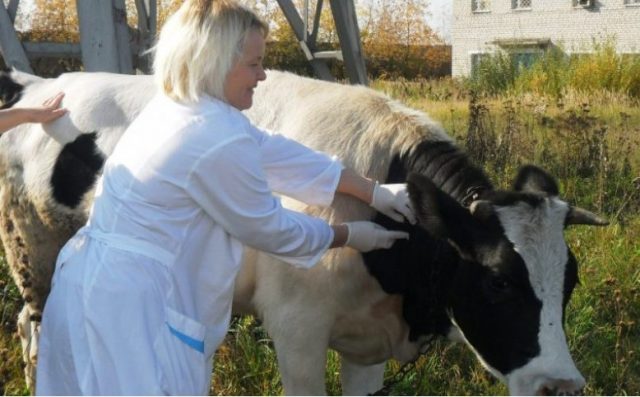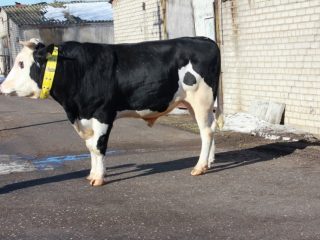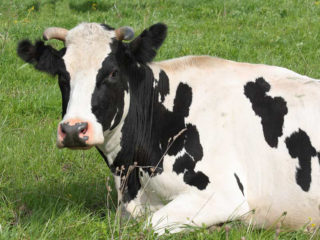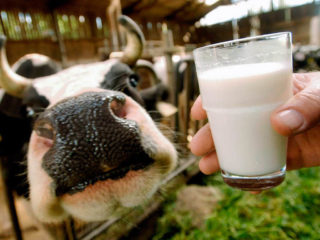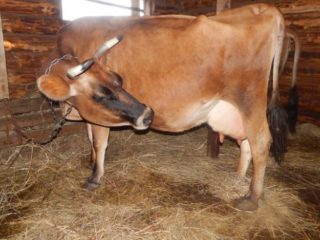Content
Cattle bursitis is a disease of the musculoskeletal system. It is common and affects productivity. Prerequisites for bursitis: lack of proper care, violation of the rules of maintenance, poor exercise. According to statistics, bursa injuries are more likely to occur when cows are crowded on hard surfaces (concrete, wood), with rare replacement of litter.
What is bursitis
A cow's bursa is a bursa (flat sac) of connective tissue. It is located in places where the joints are under maximum stress, where the mobility of muscles and tendons is maximum. The bursa (bursa) is filled with fluid, it is located in the immediate vicinity of the joint and communicates with it.
Bursitis of cattle refers to all types of inflammation of the synovial bursae. In cattle, the following bursae are affected:
- precarpal;
- hock (tarsus) joint;
- external tubercle in the iliac region.
Causes of occurrence
Mechanical joint injury is the most common cause of bursitis in cattle. It can be both external and internal. To be productive, dairy cows must lie down for at least 14 hours. For comfort, they need bedding (hay, straw, sawdust).
Injuries (bruises, abrasions) of the joints, legs of cattle occur if the bedding layer is thin or absent. This happens because when lying down, the cow falls to the floor from a height of 30 cm. She physically cannot descend smoothly.
Nowadays, rubber mats are popular with farmers due to their low cost. They are used as bedding. They are hard enough. If they are not covered with a layer of straw, then the cattle, in addition to abrasions and bruises of the legs, get hypothermia and, as a result, bursitis.
According to statistics, up to 11% of the livestock suffers from bursitis of the knee, hock and wrist joints when keeping the herd without bedding. Other causes of cattle bursa injuries:
- short leash;
- hoof kick due to high crowding in the barn;
- inconvenient feeders;
- short stalls;
- transportation.
With injuries, stretching, displacement of the synovial bag occurs, which leads to its inflammation. Infection (tuberculosis, sepsis, brucellosis) is another, no less common cause of inflammation of the bovine bursa.
Forms of the course of the disease
Cattle bursitis can occur in acute or chronic form. According to the structure of the inflammatory fluid (exudate) and changes in the tissues, the disease is divided into types:
- purulent bursitis;
- aseptic bursitis.
The latter is caused by mechanical irritation, which caused hemorrhage in the cavity of the bag and in the tissues surrounding the joint. Signs of aseptic bursitis:
- hyperemia;
- edema;
- infiltration.
Types of chronic aseptic bursitis, their symptoms are shown in the table.
Type of aseptic bursitis | Exudate characteristic |
Serous | Liquid, consisting of plasma and blood inclusions |
Serous fibrous | Fibrin present |
Fibrinous | Large particles of fibrin, consisting of epithelial cells, fill the entire cavity |
Ossifying | The cavity of the bursa is filled with fibrous tissue, in which urate and calcium salts are deposited |
Fibrin is understood as a protein produced in blood plasma. It clogs the injured vessels of the bag (bursa).This leads to thickening of the walls, proliferation of connective tissues, the formation of ridges, bridges.
If untreated, cattle can experience all stages of aseptic bursitis, from acute to chronic. In an acute form, in the area of inflammation, swelling first appears, the cow begins to limp severely. On palpation, the presence of liquid exudate is felt.
With the transition to a chronic serous, serous-fibrous form, cattle bursitis is manifested by the appearance of a dense, mobile formation in the area of inflammation. The amount of swelling depends on the location of the bursitis.
The skin in the area of inflammation loses its mobility due to accretion with the tissues of the bag. With an ossifying form of bursitis, the swelling hardens, the skin at the site of inflammation thickens. It shows foci of keratinization, hair loss. The work of the joint is impaired.
Acute purulent inflammation of the bursa proceeds in a different way. The swelling is painful, hot to the touch. When taking a puncture, the type of exudate is purulent. An animal with purulent bursitis of cattle is severely lame. The general condition is getting worse. The development of purulent-resorptive fever is not excluded.
The cause of purulent inflammation is an infection that has entered through the damaged membrane of the bag, or infectious processes occurring in the tissues adjacent to it. External manifestations of purulent cattle bursitis:
- necrosis of the walls of the bag;
- the formation of subcutaneous phlegmon;
- bursal fistulas;
- purulent discharge.
Diagnostics
The veterinarian conducts a visual examination of the animal. Assesses the general condition of cattle (temperature, pulse, rumination), habit, fatness, body position. Examines the skin for:
- elasticity;
- humidity;
- the presence and extent of damage;
- condition of the hairline.
The veterinarian feels the site of inflammation. Gives an assessment of consistency, limited swelling, soreness. Determines the degree of joint mobility.
A puncture is taken if the visual examination data is not enough to make a diagnosis. If the infectious nature of cattle bursitis is suspected, the exudate is sent for bacteriological examination, and the blood serum - for serological examination.
Treatment methods
In the treatment of cattle knee bursitis, conservative and surgical methods of treatment are used. The operation is forced to resort to purulent inflammation of the bursa and with advanced, complicated forms of aseptic bursitis.
Therapy of acute aseptic bursitis of cattle on the first day is reduced to applying cold, applying tight bandages. At the next stage, the following procedures are carried out:
- Thermal. Apply a warming compress, make a paraffin application, warm it up with a lamp.
- Rub a resorbing ointment into the area of inflammation.
- An antibiotic is injected.
They change the bedding for the cow, create a comfortable environment. If the disease is detected on time, then the swelling does not increase in size. Otherwise, its increase is observed, then the treatment regimen is changed:
- The cavity of the bursa is cleaned of exudate.
- A solution of carbolic acid (5%), iodine (3-5%), silver nitrate (5%) is introduced into the bag.
- With light massaging movements, distribute the solution over the entire area of the bursa.
- Apply a bandage.
Purulent inflammations are always treated promptly:
- The cavity is opened, cleaned, and rinsed.
- To clean the wound, hydrogen peroxide, a pink solution of potassium permanganate, and a furacilin solution are used.
- Cotton turunda is impregnated with Vishnevsky's ointment. It is put into the wound.
- Turunda is periodically replaced.
Prevention measures
Measures for the prevention of bursitis of the knee joint of cattle relate to the maintenance, nutrition, immunization of cows. Emaciated animals weakened by other infections more often suffer from inflammation of the bursa. Carrying out timely vaccination of calves, cows, competent composition of the herd ration reduce the incidence rate.
These measures increase the resistance of animals to harmful factors. There is a list of measures, during which, the percentage of development of cattle knee bursitis decreases:
- grazing cows on level, safe pastures;
- the presence of soft bedding and its regular replacement;
- no drafts in the barn;
- installation of feeders at a sufficient distance from each other;
- transportation according to the rules;
- periodic examination of cows for infectious diseases, routine vaccination.
Conclusion
It is easier to eliminate cattle bursitis at the initial stage of the disease. With competent and timely treatment, you can do without surgery. With an advanced stage of ossifying bursitis of the knee joint, the chances of recovery for cattle are minimal.


